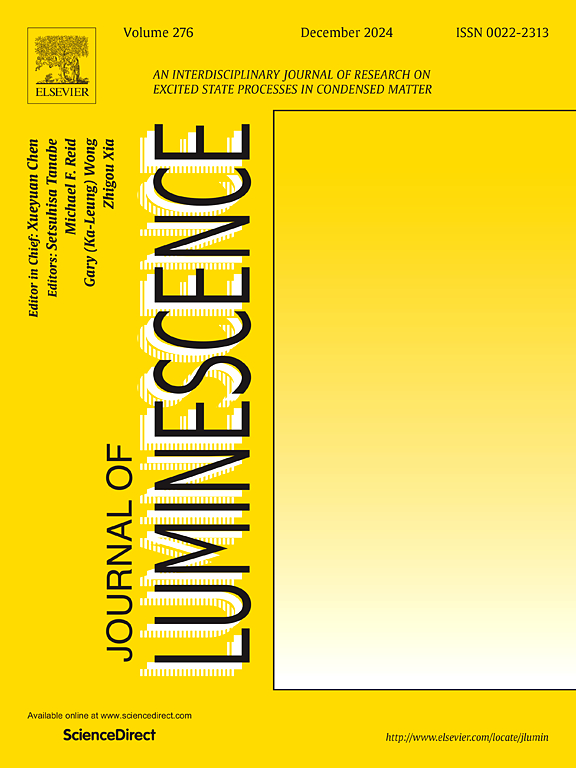基于Tb配位聚合物的多功能荧光探针用于水介质中磷酸盐阴离子和盐酸四环素抗生素的高效检测
IF 3.3
3区 物理与天体物理
Q2 OPTICS
引用次数: 0
摘要
以2,6-二(2,4-二羰基苯基)-4-(3-羧基苯基)吡啶(H5dccp)为基料,通过溶剂热反应合成了发光铽配位聚合物(CP) [Tb(H2dccp)(H2O)2·8.5(H2O)]n(1)。单晶x射线衍射表明,1在正交空间群Pbcn中结晶,呈一维链状结构。1为Tb(III)离子的特征性绿色发射,其荧光强度在pH 4 ~ 12范围内非常稳定。荧光1可通过荧光猝灭法检测水中PO43−阴离子、四环素(TC)、氯四环素(CTC)、土霉素(OTC)和脱氧四环素(DOX),检出限分别为20.6 nM、56.6 nM、59.6 nM、105.9 nM和84.8 nM。值得注意的是,PO43−阴离子的检出限为1,是迄今为止报道的基于cp的荧光探针中最低的。此外,通过紫外线灯下绿光的消失,可以用肉眼观察到检测现象。该检测机制归因于1中PO43−阴离子与Tb(III)离子之间的静电相互作用以及1与四环素抗生素(TCs)之间的荧光共振能量转移(FRET)。总的来说,1优异的荧光特性使其成为一种方便的多功能荧光探针,用于检测水中的TCs和PO43−阴离子。本文章由计算机程序翻译,如有差异,请以英文原文为准。

A multifunctional fluorescent probe based on a Tb coordination polymer for the efficient detection of phosphate anions and tetracycline hydrochloride antibiotics in aqueous media
A luminescent terbium coordination polymer (CP) [Tb(H2dccp)(H2O)2·8.5(H2O)]n (1) based on 2,6-di(2,4-dicarboxyphenyl)-4-(3-carboxyphenyl)pyridine (H5dccp) was synthesized in a solvothermal reaction. Single crystal X-ray diffraction revealed that 1 crystallizes in the orthorhombic space group Pbcn and displays a one-dimensional chain structure. 1 shows the characteristic green emission of the Tb(III) ion, and the corresponding fluorescence intensities were very stable in the pH range of 4∼12. The fluorescent of 1 can detect PO43− anions, tetracycline (TC), chlortetracycline (CTC), oxytetracycline (OTC) and deoxytetracycline (DOX) in water by fluorescence quenching, with detection limits of 20.6 nM, 56.6 nM, 59.6 nM, 105.9 nM and 84.8 nM, respectively. Remarkably, the detection limit of 1 for PO43− anions is the lowest ever reported for a CP-based fluorescence probe. Moreover, the detection phenomenon can be observed by the naked eye through the disappearance of green light under an ultraviolet lamp. The detection mechanism is attributed to the electrostatic interaction between PO43− anion and Tb(III) ion in 1 and to fluorescence resonance energy transfer (FRET) between 1 and tetracycline antibiotics (TCs). Overall, the excellent fluorescence properties of 1 make it a convenient multifunctional fluorescence probe for the detection of TCs and PO43− anions in water.
求助全文
通过发布文献求助,成功后即可免费获取论文全文。
去求助
来源期刊

Journal of Luminescence
物理-光学
CiteScore
6.70
自引率
13.90%
发文量
850
审稿时长
3.8 months
期刊介绍:
The purpose of the Journal of Luminescence is to provide a means of communication between scientists in different disciplines who share a common interest in the electronic excited states of molecular, ionic and covalent systems, whether crystalline, amorphous, or liquid.
We invite original papers and reviews on such subjects as: exciton and polariton dynamics, dynamics of localized excited states, energy and charge transport in ordered and disordered systems, radiative and non-radiative recombination, relaxation processes, vibronic interactions in electronic excited states, photochemistry in condensed systems, excited state resonance, double resonance, spin dynamics, selective excitation spectroscopy, hole burning, coherent processes in excited states, (e.g. coherent optical transients, photon echoes, transient gratings), multiphoton processes, optical bistability, photochromism, and new techniques for the study of excited states. This list is not intended to be exhaustive. Papers in the traditional areas of optical spectroscopy (absorption, MCD, luminescence, Raman scattering) are welcome. Papers on applications (phosphors, scintillators, electro- and cathodo-luminescence, radiography, bioimaging, solar energy, energy conversion, etc.) are also welcome if they present results of scientific, rather than only technological interest. However, papers containing purely theoretical results, not related to phenomena in the excited states, as well as papers using luminescence spectroscopy to perform routine analytical chemistry or biochemistry procedures, are outside the scope of the journal. Some exceptions will be possible at the discretion of the editors.
 求助内容:
求助内容: 应助结果提醒方式:
应助结果提醒方式:


